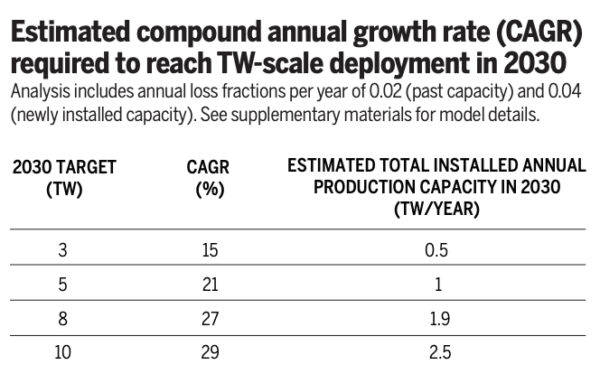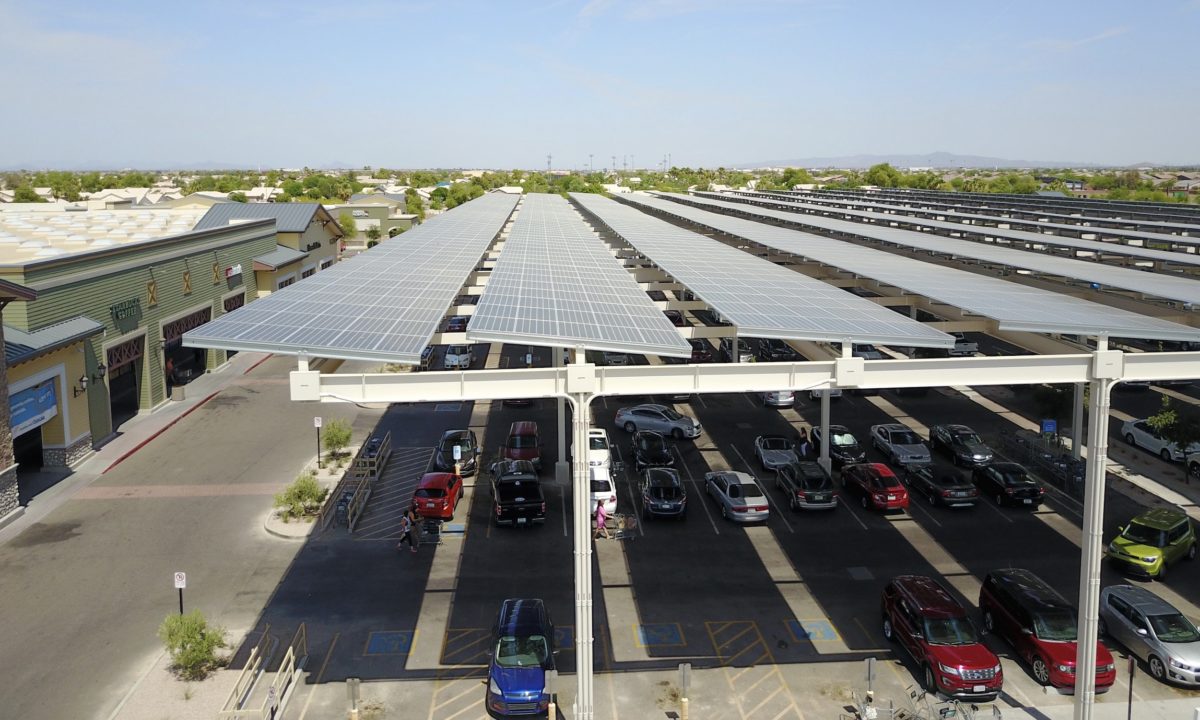Global PV installations increased only 1% last year to 94.3 GW, according to the International Renewable Energy Agency—a sharp drop from increases ranging from 29-48% from 2014 to 2017. U.S. additions were also lackluster, somewhere between up 6% (per BNEF) to down 2% (per SEIA).
Last year’s results represent a pause from a steady march toward 5-10 terawatts of PV globally by 2030, which could be met by sustained annual installation growth of at least 21% per year, as seen in this table from the Science magazine article “Terawatt-Scale Photovoltaics: Trajectories and challenges”:
 Image: Science magazine
Image: Science magazine
The article, co-authored by 21 experts primarily from the U.S., Germany and Japan, stated that the compound annual growth rates shown (including the top rate of 29%) were “challenging but feasible.” The concept of a compound annual growth rate that could quickly achieve PV’s potential can serve as a touchstone for gauging progress toward Paris Accord goals or other renewables targets.
At a 29% compounded rate, global PV installations would more than double every three years—as was the case from 2014 (37 GW installed) to 2017 (nearly 94 GW installed).
Getting back to substantial growth in annual installations
Five challenges to reaching 5-10 terawatts of PV capacity by 2030 were noted by the U.S./German/Japanese solar research consortium GA-SERI, which coordinated the “Terawatt-scale photovoltaics” analysis:
- Continued PV module cost reductions and performance gains
- Reducing the capital cost and time required to build module factories and install PV
- More flexible grids that can handle high levels of PV through increased load shifting, energy storage, or transmission
- Increased demand for electricity for transportation and heating
- Continued progress in storage.
Reflecting on these challenges, Dr. Nancy Haegel, senior author of the “Terawatt-scale” article, said that many analysts predict that PV globally will reach an installed base of one terawatt (1,000 GW) “sometime in the next 2-3 years.” (GA-SERI analysts are among them.) That would be a doubling of the current installed base, implying a compound annual growth rate of more than 25% over three years. Low PV prices would contribute to that growth, Dr. Haegel implied, noting that the global average module price had fallen below 25 cents per watt at the end of 2018. PV technology is Dr. Haegel’s area of specialty, as she directs the National Renewable Energy Laboratory (NREL) Materials Science Center. She also noted the importance of “worldwide research efforts in foundational science for storage, grid integration and pathways to electrification” in driving progress toward terawatt-scale PV.
A similar note was sounded by Dr. Sarah Kurtz, a co-author of the “Terawatt-scale” article, who said “The constant size of deployments in 2017 and 2018, despite the Chinese ‘pause’ and the U.S. tariffs in 2018, is actually a positive sign. There might have been a reduction because of those two events.” She noted that progress is being made on all five challenge areas, and said that reaching 5-10 TW by 2030 doesn’t require growth in deployments every year. Dr. Kurtz, who teamed with Dr. Haegel while at NREL, now teaches at the University of California, Merced.
This content is protected by copyright and may not be reused. If you want to cooperate with us and would like to reuse some of our content, please contact: editors@pv-magazine.com.








This information is useful for users who plan to invest in renewable energy…